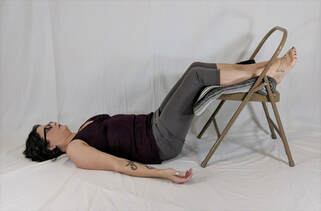|
Cheryl Fenner Brown, C-IAYT, E-RYT 500 This article also appeared in the Yoga U Online Wellness Blog, February 2019 You probably know the feeling - lying in bed for hours on end looking at the clock with the mind swirling, chattering and generally keeping you from falling asleep. You re-play the events of the day getting caught in circular thoughts like “Why did I say that?”, “Why didn’t I stand up for myself at work?”, or “How am I going to pay my bills?”. The frustration of insomnia spills over into the next day and you find yourself reaching for another cup of coffee to make it through the day. One in four Americans experience insomnia every year, with 75% of those sufferers recovering without developing chronic insomnia (1). Cancer, Insomina & Immunity For cancer patients, the stress of diagnosis and treatment can be cause for greater insomnia. In fact, recently treated cancer patients are twice as likely to develop sleep disturbances as the general population (2). It is not only the swirling stressful thoughts that keep patients awake, but muscle and joint pain may prevent them from finding comfort and achieving deep restful sleep. Many steroidal cancer medications can also cause insomnia, and patients often need prescription sleeping aids to overcome it. Regular sleep is so important to every aspect of life, from physically feeling better to being able to think more clearly. From being in a better mood to being able to heal more quickly. Sleep enhances immunity at the cellular level allowing immune cells to be created and tissue to be repaired. Unfortunately, stressful sleep-less nights have both and an immediate and long-term detrimental effect on the health of the immune system. (3). For cancer patients or people whose immune systems are already compromised by treatments, sleep is an important part of supporting the body’s natural healing processes. You Deserve Better Sleep But how do we get better sleep? There are many ways to increase sleep hygiene including maintaining a set bedtime, creating a relaxing pre-sleep routine like taking a hot bath or drinking herbal tea, limiting light and electronic devices in the bedroom, and creating a warm inviting sleep environment. Yoga practices can also help improve sleep and over 55% of yoga practitioners report that yoga helps them sleep better (4). Specifically, we will be looking at practices that activate the parasympathetic nervous system, or “rest and digest” response. This part of the nervous system counteracts chronic over stimulation of the sympathetic nervous system, or “flight or fight” response caused by living in the modern world. Yoga for Insomnia The yoga practice that follows is a combination of practices to enable easier sleep. It consists of mudra to help quiet the late-night ruminations of the mind, gentle spinal movements to ease body aches, calming pranayama to release stress, and a mild inversion to initiate the relaxation response. Practice in the hour before you go to bed to take advantage of the sleep-inducing benefits. Yoga Practice Tips
 Stating Intention with Vajrapradama Mudra Stating an intention, or sankalpa, is an important first step toward using yoga as a healing practice. Combining intention with the following mudra that settles doubts by enhancing your ability to trust yourself can serve as a reminder of your goals during this time.
 Apanasana When a stiff and achy body contributes to sleepless nights, movement is often needed to release tension, ease pain, and relax muscles so that sleep can come more easily, especially if you experience occasional restless leg syndrome or cramping at night. Try this simple effective series of movements that can be done on the floor or reclining in bed.
 Reclining Twist A gentle twist can be helpful for releasing muscular tension from the hips and lower back which may help you to be more comfortable when you recline to sleep. Try this version on the floor or on top of your bed.
 Chair Forward Fold A gentle forward bend shares the tension relieving benefits of the reclining twist above as well as calming mental and emotional energy that can help to prepare the body and mind for sleep. Try this version with the head supported by a chair to ensure a sense of surrender and ease.
 Chandra Bhedana (Left Nostril Breathing) Different breathing patterns create different effects and here you will practice a pranayama that can calm a swirling mind. In this pattern you will breathe in through the left nostril which activates ida nadi. This left pranic channel is often called the moon channel and is cooler, calmer and more introspective than the right channel. You will then exhale through the right nostril which is associated with pingala nadi, the more active or solar channel. Imagine that you are allowing calming lunar energy to flow through your active busy mind.
 Legs in Chair Elevating the legs before you go to sleep can help in several ways. It will relax the lower back and help to release deeply-held tension in the hips. The mild inversion also shifts the flow of blood from the feet towards the heart and sends a signal to the parasympathetic nervous system to activate the relaxation response. It takes some time for this internal shift to occur, so rest here for as long as you feel comfortable.
References
0 Comments
Leave a Reply. |
Index:Archives:
September 2022
I attend Cheryl's class regularly and feel that my practice has improved immensely over the past few years due to her expert coaching. Her teaching style is clear and compassionate and her previous experience in teaching adults is evident in her organized approach and easy to understand instructions. I also appreciate that Cheryl not only teaches us about how to correctly position ourselves, but also touches on many aspects of yoga philosophy, which in turn has deepened my personal practice and heightened my awareness of the connection between mind and body, breath and relaxation. |

 RSS Feed
RSS Feed
